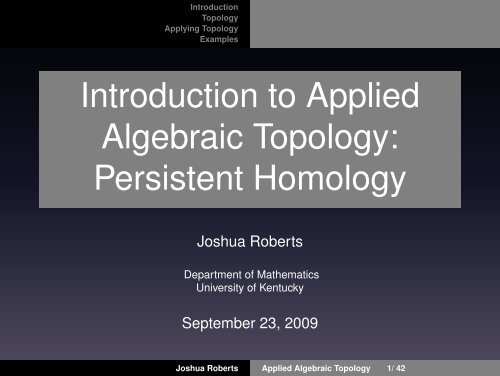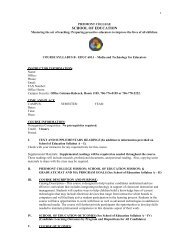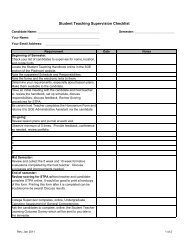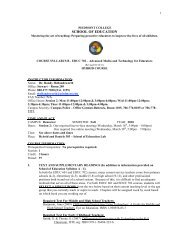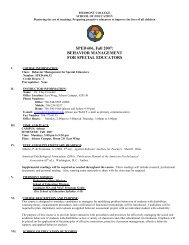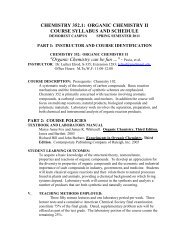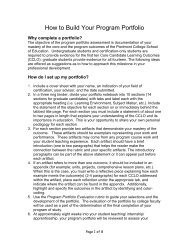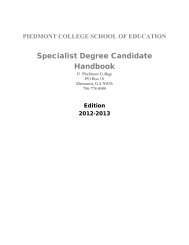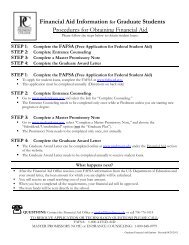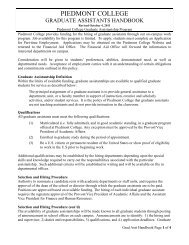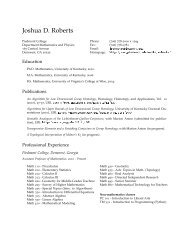Introduction to Applied Algebraic Topology: Persistent Homology
Introduction to Applied Algebraic Topology: Persistent Homology
Introduction to Applied Algebraic Topology: Persistent Homology
Create successful ePaper yourself
Turn your PDF publications into a flip-book with our unique Google optimized e-Paper software.
<strong>Introduction</strong><br />
<strong>Topology</strong><br />
Applying <strong>Topology</strong><br />
Examples<br />
<strong>Introduction</strong> <strong>to</strong> <strong>Applied</strong><br />
<strong>Algebraic</strong> <strong>Topology</strong>:<br />
<strong>Persistent</strong> <strong>Homology</strong><br />
Joshua Roberts<br />
Department of Mathematics<br />
University of Kentucky<br />
September 23, 2009<br />
Joshua Roberts <strong>Applied</strong> <strong>Algebraic</strong> <strong>Topology</strong> 1/ 42
Outline<br />
<strong>Introduction</strong><br />
<strong>Topology</strong><br />
Applying <strong>Topology</strong><br />
Examples<br />
<strong>Introduction</strong><br />
<strong>Topology</strong><br />
Simplicial Complex<br />
<strong>Homology</strong><br />
Applying <strong>Topology</strong><br />
Point-Cloud Data<br />
Persistence<br />
Examples<br />
Phonemes<br />
Autism<br />
Joshua Roberts <strong>Applied</strong> <strong>Algebraic</strong> <strong>Topology</strong> 2/ 42
<strong>Introduction</strong><br />
<strong>Topology</strong><br />
Applying <strong>Topology</strong><br />
Examples<br />
What is <strong>Algebraic</strong> <strong>Topology</strong>? (The<br />
<strong>Topology</strong> Part)<br />
Joshua Roberts <strong>Applied</strong> <strong>Algebraic</strong> <strong>Topology</strong> 3/ 42
<strong>Introduction</strong><br />
<strong>Topology</strong><br />
Applying <strong>Topology</strong><br />
Examples<br />
What is <strong>Algebraic</strong> <strong>Topology</strong>? (The<br />
<strong>Topology</strong> Part)<br />
• <strong>Topology</strong> - Study of shapes that can be deformed<br />
continuously in<strong>to</strong> other shapes<br />
Joshua Roberts <strong>Applied</strong> <strong>Algebraic</strong> <strong>Topology</strong> 3/ 42
<strong>Introduction</strong><br />
<strong>Topology</strong><br />
Applying <strong>Topology</strong><br />
Examples<br />
What is <strong>Algebraic</strong> <strong>Topology</strong>? (The<br />
<strong>Topology</strong> Part)<br />
• <strong>Topology</strong> - Study of shapes that can be deformed<br />
continuously in<strong>to</strong> other shapes<br />
• The surface of a cube can be “flattened” <strong>to</strong> a sphere, they<br />
are homeomorphic (<strong>to</strong>pologically equivalent)<br />
Joshua Roberts <strong>Applied</strong> <strong>Algebraic</strong> <strong>Topology</strong> 3/ 42
<strong>Introduction</strong><br />
<strong>Topology</strong><br />
Applying <strong>Topology</strong><br />
Examples<br />
What is <strong>Algebraic</strong> <strong>Topology</strong>? (The<br />
<strong>Topology</strong> Part)<br />
• <strong>Topology</strong> - Study of shapes that can be deformed<br />
continuously in<strong>to</strong> other shapes<br />
• The surface of a cube can be “flattened” <strong>to</strong> a sphere, they<br />
are homeomorphic (<strong>to</strong>pologically equivalent)<br />
...also...<br />
Joshua Roberts <strong>Applied</strong> <strong>Algebraic</strong> <strong>Topology</strong> 3/ 42
<strong>Introduction</strong><br />
<strong>Topology</strong><br />
Applying <strong>Topology</strong><br />
Examples<br />
What is <strong>Algebraic</strong> <strong>Topology</strong>? (The<br />
<strong>Topology</strong> Part)<br />
• <strong>Topology</strong> - Study of shapes that can be deformed<br />
continuously in<strong>to</strong> other shapes<br />
• The surface of a cube can be “flattened” <strong>to</strong> a sphere, they<br />
are homeomorphic (<strong>to</strong>pologically equivalent)<br />
...also...<br />
Click Me!!!<br />
Joshua Roberts <strong>Applied</strong> <strong>Algebraic</strong> <strong>Topology</strong> 3/ 42
<strong>Introduction</strong><br />
<strong>Topology</strong><br />
Applying <strong>Topology</strong><br />
Examples<br />
Homo<strong>to</strong>py Equivalence<br />
Joshua Roberts <strong>Applied</strong> <strong>Algebraic</strong> <strong>Topology</strong> 4/ 42
<strong>Introduction</strong><br />
<strong>Topology</strong><br />
Applying <strong>Topology</strong><br />
Examples<br />
Homo<strong>to</strong>py Equivalence<br />
• Problem - Homeomorphism is <strong>to</strong>o strong!<br />
Joshua Roberts <strong>Applied</strong> <strong>Algebraic</strong> <strong>Topology</strong> 4/ 42
<strong>Introduction</strong><br />
<strong>Topology</strong><br />
Applying <strong>Topology</strong><br />
Examples<br />
Homo<strong>to</strong>py Equivalence<br />
• Problem - Homeomorphism is <strong>to</strong>o strong! Difficult <strong>to</strong><br />
classify <strong>to</strong>pological spaces up <strong>to</strong> homeomorphism<br />
Joshua Roberts <strong>Applied</strong> <strong>Algebraic</strong> <strong>Topology</strong> 4/ 42
<strong>Introduction</strong><br />
<strong>Topology</strong><br />
Applying <strong>Topology</strong><br />
Examples<br />
Homo<strong>to</strong>py Equivalence<br />
• Problem - Homeomorphism is <strong>to</strong>o strong! Difficult <strong>to</strong><br />
classify <strong>to</strong>pological spaces up <strong>to</strong> homeomorphism<br />
• Solution - Homo<strong>to</strong>py!<br />
Joshua Roberts <strong>Applied</strong> <strong>Algebraic</strong> <strong>Topology</strong> 4/ 42
<strong>Introduction</strong><br />
<strong>Topology</strong><br />
Applying <strong>Topology</strong><br />
Examples<br />
Homo<strong>to</strong>py Equivalence<br />
• Problem - Homeomorphism is <strong>to</strong>o strong! Difficult <strong>to</strong><br />
classify <strong>to</strong>pological spaces up <strong>to</strong> homeomorphism<br />
• Solution - Homo<strong>to</strong>py! Intuitively, two spaces are homo<strong>to</strong>py<br />
equivalent if one can be deformed in<strong>to</strong> the other, allowing<br />
contractions and expansion<br />
Joshua Roberts <strong>Applied</strong> <strong>Algebraic</strong> <strong>Topology</strong> 4/ 42
<strong>Introduction</strong><br />
<strong>Topology</strong><br />
Applying <strong>Topology</strong><br />
Examples<br />
Homo<strong>to</strong>py Equivalence<br />
• Problem - Homeomorphism is <strong>to</strong>o strong! Difficult <strong>to</strong><br />
classify <strong>to</strong>pological spaces up <strong>to</strong> homeomorphism<br />
• Solution - Homo<strong>to</strong>py! Intuitively, two spaces are homo<strong>to</strong>py<br />
equivalent if one can be deformed in<strong>to</strong> the other, allowing<br />
contractions and expansion<br />
• Ex:<br />
Joshua Roberts <strong>Applied</strong> <strong>Algebraic</strong> <strong>Topology</strong> 4/ 42
<strong>Introduction</strong><br />
<strong>Topology</strong><br />
Applying <strong>Topology</strong><br />
Examples<br />
What is <strong>Algebraic</strong> <strong>Topology</strong>?<br />
Joshua Roberts <strong>Applied</strong> <strong>Algebraic</strong> <strong>Topology</strong> 5/ 42
<strong>Introduction</strong><br />
<strong>Topology</strong><br />
Applying <strong>Topology</strong><br />
Examples<br />
What is <strong>Algebraic</strong> <strong>Topology</strong>?<br />
• <strong>Algebraic</strong> <strong>to</strong>pology assigns algebraic invariants <strong>to</strong><br />
<strong>to</strong>pological spaces.<br />
Joshua Roberts <strong>Applied</strong> <strong>Algebraic</strong> <strong>Topology</strong> 5/ 42
<strong>Introduction</strong><br />
<strong>Topology</strong><br />
Applying <strong>Topology</strong><br />
Examples<br />
What is <strong>Algebraic</strong> <strong>Topology</strong>?<br />
• <strong>Algebraic</strong> <strong>to</strong>pology assigns algebraic invariants <strong>to</strong><br />
<strong>to</strong>pological spaces.<br />
• χ - Euler characteristic<br />
Joshua Roberts <strong>Applied</strong> <strong>Algebraic</strong> <strong>Topology</strong> 5/ 42
<strong>Introduction</strong><br />
<strong>Topology</strong><br />
Applying <strong>Topology</strong><br />
Examples<br />
What is <strong>Algebraic</strong> <strong>Topology</strong>?<br />
• <strong>Algebraic</strong> <strong>to</strong>pology assigns algebraic invariants <strong>to</strong><br />
<strong>to</strong>pological spaces.<br />
• χ - Euler characteristic - Assigns integers <strong>to</strong> <strong>to</strong>pological<br />
spaces<br />
Joshua Roberts <strong>Applied</strong> <strong>Algebraic</strong> <strong>Topology</strong> 5/ 42
<strong>Introduction</strong><br />
<strong>Topology</strong><br />
Applying <strong>Topology</strong><br />
Examples<br />
What is <strong>Algebraic</strong> <strong>Topology</strong>?<br />
• <strong>Algebraic</strong> <strong>to</strong>pology assigns algebraic invariants <strong>to</strong><br />
<strong>to</strong>pological spaces.<br />
• χ - Euler characteristic - Assigns integers <strong>to</strong> <strong>to</strong>pological<br />
spaces - Homo<strong>to</strong>py Invariant<br />
Joshua Roberts <strong>Applied</strong> <strong>Algebraic</strong> <strong>Topology</strong> 5/ 42
<strong>Introduction</strong><br />
<strong>Topology</strong><br />
Applying <strong>Topology</strong><br />
Examples<br />
What is <strong>Algebraic</strong> <strong>Topology</strong>?<br />
• <strong>Algebraic</strong> <strong>to</strong>pology assigns algebraic invariants <strong>to</strong><br />
<strong>to</strong>pological spaces.<br />
• χ - Euler characteristic - Assigns integers <strong>to</strong> <strong>to</strong>pological<br />
spaces - Homo<strong>to</strong>py Invariant<br />
• If X is homo<strong>to</strong>py equivalent <strong>to</strong> a polyhedron,<br />
χ(X) = #v − #e + #f<br />
Joshua Roberts <strong>Applied</strong> <strong>Algebraic</strong> <strong>Topology</strong> 5/ 42
<strong>Introduction</strong><br />
<strong>Topology</strong><br />
Applying <strong>Topology</strong><br />
Examples<br />
Euler characteristic<br />
Theorem<br />
The Euler characteristic completely classifies (compact,<br />
oriented) surfaces.<br />
Joshua Roberts <strong>Applied</strong> <strong>Algebraic</strong> <strong>Topology</strong> 6/ 42
<strong>Introduction</strong><br />
<strong>Topology</strong><br />
Applying <strong>Topology</strong><br />
Examples<br />
Euler characteristic<br />
Theorem<br />
The Euler characteristic completely classifies (compact,<br />
oriented) surfaces.<br />
Joshua Roberts <strong>Applied</strong> <strong>Algebraic</strong> <strong>Topology</strong> 6/ 42
<strong>Introduction</strong><br />
<strong>Topology</strong><br />
Applying <strong>Topology</strong><br />
Examples<br />
Euler characteristic<br />
Theorem<br />
The Euler characteristic completely classifies (compact,<br />
oriented) surfaces.<br />
Joshua Roberts <strong>Applied</strong> <strong>Algebraic</strong> <strong>Topology</strong> 6/ 42
<strong>Introduction</strong><br />
<strong>Topology</strong><br />
Applying <strong>Topology</strong><br />
Examples<br />
Euler characteristic<br />
Theorem<br />
The Euler characteristic completely classifies (compact,<br />
oriented) surfaces.<br />
Joshua Roberts <strong>Applied</strong> <strong>Algebraic</strong> <strong>Topology</strong> 6/ 42
<strong>Introduction</strong><br />
<strong>Topology</strong><br />
Applying <strong>Topology</strong><br />
Examples<br />
Euler characteristic<br />
Theorem<br />
The Euler characteristic completely classifies (compact,<br />
oriented) surfaces.<br />
Joshua Roberts <strong>Applied</strong> <strong>Algebraic</strong> <strong>Topology</strong> 6/ 42
<strong>Introduction</strong><br />
<strong>Topology</strong><br />
Applying <strong>Topology</strong><br />
Examples<br />
Euler characteristic<br />
Theorem<br />
The Euler characteristic completely classifies (compact,<br />
oriented) surfaces.<br />
Joshua Roberts <strong>Applied</strong> <strong>Algebraic</strong> <strong>Topology</strong> 6/ 42
<strong>Introduction</strong><br />
<strong>Topology</strong><br />
Applying <strong>Topology</strong><br />
Examples<br />
“<strong>Topology</strong>! The stra<strong>to</strong>sphere of human thought! In the<br />
twenty-fourth century it might possibly be of use <strong>to</strong> someone...”<br />
The First Circle, A. Solzhenitsyn<br />
Joshua Roberts <strong>Applied</strong> <strong>Algebraic</strong> <strong>Topology</strong> 7/ 42
Outline<br />
<strong>Introduction</strong><br />
<strong>Topology</strong><br />
Applying <strong>Topology</strong><br />
Examples<br />
Simplicial Complex<br />
<strong>Homology</strong><br />
<strong>Introduction</strong><br />
<strong>Topology</strong><br />
Simplicial Complex<br />
<strong>Homology</strong><br />
Applying <strong>Topology</strong><br />
Point-Cloud Data<br />
Persistence<br />
Examples<br />
Phonemes<br />
Autism<br />
Joshua Roberts <strong>Applied</strong> <strong>Algebraic</strong> <strong>Topology</strong> 8/ 42
Simplices<br />
<strong>Introduction</strong><br />
<strong>Topology</strong><br />
Applying <strong>Topology</strong><br />
Examples<br />
Simplicial Complex<br />
<strong>Homology</strong><br />
Joshua Roberts <strong>Applied</strong> <strong>Algebraic</strong> <strong>Topology</strong> 9/ 42
Simplices<br />
<strong>Introduction</strong><br />
<strong>Topology</strong><br />
Applying <strong>Topology</strong><br />
Examples<br />
Simplicial Complex<br />
<strong>Homology</strong><br />
• A simplex is the convex hull of a collection of points in<br />
“general position”<br />
Joshua Roberts <strong>Applied</strong> <strong>Algebraic</strong> <strong>Topology</strong> 9/ 42
Simplices<br />
<strong>Introduction</strong><br />
<strong>Topology</strong><br />
Applying <strong>Topology</strong><br />
Examples<br />
Simplicial Complex<br />
<strong>Homology</strong><br />
• A simplex is the convex hull of a collection of points in<br />
“general position”<br />
• A 4-simplex is ...<br />
Joshua Roberts <strong>Applied</strong> <strong>Algebraic</strong> <strong>Topology</strong> 9/ 42
Simplices<br />
<strong>Introduction</strong><br />
<strong>Topology</strong><br />
Applying <strong>Topology</strong><br />
Examples<br />
Simplicial Complex<br />
<strong>Homology</strong><br />
• A simplex is the convex hull of a collection of points in<br />
“general position”<br />
• A 4-simplex is ... (you get the idea)<br />
Joshua Roberts <strong>Applied</strong> <strong>Algebraic</strong> <strong>Topology</strong> 9/ 42
<strong>Introduction</strong><br />
<strong>Topology</strong><br />
Applying <strong>Topology</strong><br />
Examples<br />
Simplicial Complexes<br />
Simplicial Complex<br />
<strong>Homology</strong><br />
• A simplicial complex is a bunch of simplices glued <strong>to</strong>gether<br />
so that the intersection of any two simplicies is another<br />
simplex.<br />
Joshua Roberts <strong>Applied</strong> <strong>Algebraic</strong> <strong>Topology</strong> 10/ 42
<strong>Introduction</strong><br />
<strong>Topology</strong><br />
Applying <strong>Topology</strong><br />
Examples<br />
Simplicial Complexes<br />
Simplicial Complex<br />
<strong>Homology</strong><br />
• A simplicial complex is a bunch of simplices glued <strong>to</strong>gether<br />
so that the intersection of any two simplicies is another<br />
simplex.<br />
Figure:<br />
Simplicial<br />
Complexes<br />
Joshua Roberts <strong>Applied</strong> <strong>Algebraic</strong> <strong>Topology</strong> 10/ 42
<strong>Introduction</strong><br />
<strong>Topology</strong><br />
Applying <strong>Topology</strong><br />
Examples<br />
Simplicial Complexes<br />
Simplicial Complex<br />
<strong>Homology</strong><br />
• A simplicial complex is a bunch of simplices glued <strong>to</strong>gether<br />
so that the intersection of any two simplicies is another<br />
simplex.<br />
Figure:<br />
Simplicial<br />
Complexes<br />
Figure: Not a<br />
Simplicial<br />
Complex<br />
Joshua Roberts <strong>Applied</strong> <strong>Algebraic</strong> <strong>Topology</strong> 10/ 42
Triangulations<br />
<strong>Introduction</strong><br />
<strong>Topology</strong><br />
Applying <strong>Topology</strong><br />
Examples<br />
Simplicial Complex<br />
<strong>Homology</strong><br />
Theorem<br />
Every <strong>to</strong>pological space (manifold) up <strong>to</strong> dimension three is<br />
homeomorphic <strong>to</strong> a simplicial complex.<br />
Joshua Roberts <strong>Applied</strong> <strong>Algebraic</strong> <strong>Topology</strong> 11/ 42
Triangulations<br />
<strong>Introduction</strong><br />
<strong>Topology</strong><br />
Applying <strong>Topology</strong><br />
Examples<br />
Simplicial Complex<br />
<strong>Homology</strong><br />
Theorem<br />
Every <strong>to</strong>pological space (manifold) up <strong>to</strong> dimension three is<br />
homeomorphic <strong>to</strong> a simplicial complex.<br />
This is called a triangulation of the space.<br />
Joshua Roberts <strong>Applied</strong> <strong>Algebraic</strong> <strong>Topology</strong> 11/ 42
Triangulations<br />
<strong>Introduction</strong><br />
<strong>Topology</strong><br />
Applying <strong>Topology</strong><br />
Examples<br />
Simplicial Complex<br />
<strong>Homology</strong><br />
Theorem<br />
Every <strong>to</strong>pological space (manifold) up <strong>to</strong> dimension three is<br />
homeomorphic <strong>to</strong> a simplicial complex.<br />
This is called a triangulation of the space.<br />
Joshua Roberts <strong>Applied</strong> <strong>Algebraic</strong> <strong>Topology</strong> 11/ 42
<strong>Introduction</strong><br />
<strong>Topology</strong><br />
Applying <strong>Topology</strong><br />
Examples<br />
Simplicial Complex<br />
<strong>Homology</strong><br />
Complexes <strong>to</strong> Vec<strong>to</strong>r Spaces<br />
• Given a simplicial complex, we can associate vec<strong>to</strong>r<br />
spaces (over a chosen field) corresponding <strong>to</strong> n-simplicies,<br />
where a simplex is a basis element for the vec<strong>to</strong>r space.<br />
Joshua Roberts <strong>Applied</strong> <strong>Algebraic</strong> <strong>Topology</strong> 12/ 42
<strong>Introduction</strong><br />
<strong>Topology</strong><br />
Applying <strong>Topology</strong><br />
Examples<br />
Simplicial Complex<br />
<strong>Homology</strong><br />
Complexes <strong>to</strong> Vec<strong>to</strong>r Spaces<br />
• Given a simplicial complex, we can associate vec<strong>to</strong>r<br />
spaces (over a chosen field) corresponding <strong>to</strong> n-simplicies,<br />
where a simplex is a basis element for the vec<strong>to</strong>r space.<br />
Let X be the simplicial complex ...<br />
Joshua Roberts <strong>Applied</strong> <strong>Algebraic</strong> <strong>Topology</strong> 12/ 42
<strong>Introduction</strong><br />
<strong>Topology</strong><br />
Applying <strong>Topology</strong><br />
Examples<br />
Simplicial Complex<br />
<strong>Homology</strong><br />
Complexes <strong>to</strong> Vec<strong>to</strong>r Spaces<br />
• Given a simplicial complex, we can associate vec<strong>to</strong>r<br />
spaces (over a chosen field) corresponding <strong>to</strong> n-simplicies,<br />
where a simplex is a basis element for the vec<strong>to</strong>r space.<br />
Let X be the simplicial complex ...<br />
• C 0 (X) = F 2v × F 2w × F 2x × F 2y × F 2z<br />
Joshua Roberts <strong>Applied</strong> <strong>Algebraic</strong> <strong>Topology</strong> 12/ 42
<strong>Introduction</strong><br />
<strong>Topology</strong><br />
Applying <strong>Topology</strong><br />
Examples<br />
Simplicial Complex<br />
<strong>Homology</strong><br />
Complexes <strong>to</strong> Vec<strong>to</strong>r Spaces<br />
• Given a simplicial complex, we can associate vec<strong>to</strong>r<br />
spaces (over a chosen field) corresponding <strong>to</strong> n-simplicies,<br />
where a simplex is a basis element for the vec<strong>to</strong>r space.<br />
Let X be the simplicial complex ...<br />
• C 0 (X) = F 2v × F 2w × F 2x × F 2y × F 2z<br />
• C 1 (X) = F 2a × F 2b × F 2c × F 2d × F 2e × F 2f<br />
Joshua Roberts <strong>Applied</strong> <strong>Algebraic</strong> <strong>Topology</strong> 12/ 42
<strong>Introduction</strong><br />
<strong>Topology</strong><br />
Applying <strong>Topology</strong><br />
Examples<br />
Simplicial Complex<br />
<strong>Homology</strong><br />
Complexes <strong>to</strong> Vec<strong>to</strong>r Spaces<br />
• Given a simplicial complex, we can associate vec<strong>to</strong>r<br />
spaces (over a chosen field) corresponding <strong>to</strong> n-simplicies,<br />
where a simplex is a basis element for the vec<strong>to</strong>r space.<br />
Let X be the simplicial complex ...<br />
• C 0 (X) = F 2v × F 2w × F 2x × F 2y × F 2z<br />
• C 1 (X) = F 2a × F 2b × F 2c × F 2d × F 2e × F 2f<br />
• C 2 (X) = F 2K<br />
Joshua Roberts <strong>Applied</strong> <strong>Algebraic</strong> <strong>Topology</strong> 12/ 42
<strong>Introduction</strong><br />
<strong>Topology</strong><br />
Applying <strong>Topology</strong><br />
Examples<br />
Simplicial Complex<br />
<strong>Homology</strong><br />
Complexes <strong>to</strong> Vec<strong>to</strong>r Spaces<br />
• Given a simplicial complex, we can associate vec<strong>to</strong>r<br />
spaces (over a chosen field) corresponding <strong>to</strong> n-simplicies,<br />
where a simplex is a basis element for the vec<strong>to</strong>r space.<br />
Let X be the simplicial complex ...<br />
• C 0 (X) = F 2v × F 2w × F 2x × F 2y × F 2z<br />
• C 1 (X) = F 2a × F 2b × F 2c × F 2d × F 2e × F 2f<br />
• C 2 (X) = F 2K<br />
• C n (X) = 0 for n ≥ 3<br />
Joshua Roberts <strong>Applied</strong> <strong>Algebraic</strong> <strong>Topology</strong> 12/ 42
Outline<br />
<strong>Introduction</strong><br />
<strong>Topology</strong><br />
Applying <strong>Topology</strong><br />
Examples<br />
Simplicial Complex<br />
<strong>Homology</strong><br />
<strong>Introduction</strong><br />
<strong>Topology</strong><br />
Simplicial Complex<br />
<strong>Homology</strong><br />
Applying <strong>Topology</strong><br />
Point-Cloud Data<br />
Persistence<br />
Examples<br />
Phonemes<br />
Autism<br />
Joshua Roberts <strong>Applied</strong> <strong>Algebraic</strong> <strong>Topology</strong> 13/ 42
<strong>Introduction</strong><br />
<strong>Topology</strong><br />
Applying <strong>Topology</strong><br />
Examples<br />
Simplicial <strong>Homology</strong><br />
Simplicial Complex<br />
<strong>Homology</strong><br />
• Given a simplicial complex X, Define the<br />
n th homology of X <strong>to</strong> be the quotient<br />
vec<strong>to</strong>r space<br />
Joshua Roberts <strong>Applied</strong> <strong>Algebraic</strong> <strong>Topology</strong> 14/ 42
<strong>Introduction</strong><br />
<strong>Topology</strong><br />
Applying <strong>Topology</strong><br />
Examples<br />
Simplicial <strong>Homology</strong><br />
Simplicial Complex<br />
<strong>Homology</strong><br />
• Given a simplicial complex X, Define the<br />
n th homology of X <strong>to</strong> be the quotient<br />
vec<strong>to</strong>r space<br />
H n (X) = “Cycles”/“Boundaries”<br />
Joshua Roberts <strong>Applied</strong> <strong>Algebraic</strong> <strong>Topology</strong> 14/ 42
<strong>Introduction</strong><br />
<strong>Topology</strong><br />
Applying <strong>Topology</strong><br />
Examples<br />
Simplicial <strong>Homology</strong><br />
Simplicial Complex<br />
<strong>Homology</strong><br />
• Given a simplicial complex X, Define the<br />
n th homology of X <strong>to</strong> be the quotient<br />
vec<strong>to</strong>r space<br />
H n (X) = “Cycles”/“Boundaries”<br />
H 1 (X)<br />
= ([a + b + c] + [d + e + f ])/∂K<br />
Joshua Roberts <strong>Applied</strong> <strong>Algebraic</strong> <strong>Topology</strong> 14/ 42
<strong>Introduction</strong><br />
<strong>Topology</strong><br />
Applying <strong>Topology</strong><br />
Examples<br />
Simplicial <strong>Homology</strong><br />
Simplicial Complex<br />
<strong>Homology</strong><br />
• Given a simplicial complex X, Define the<br />
n th homology of X <strong>to</strong> be the quotient<br />
vec<strong>to</strong>r space<br />
H n (X) = “Cycles”/“Boundaries”<br />
H 1 (X)<br />
= ([a + b + c] + [d + e + f ])/∂K<br />
= ([a + b + c] + [d + e + f ])/[a + b + c]<br />
Joshua Roberts <strong>Applied</strong> <strong>Algebraic</strong> <strong>Topology</strong> 14/ 42
<strong>Introduction</strong><br />
<strong>Topology</strong><br />
Applying <strong>Topology</strong><br />
Examples<br />
Simplicial <strong>Homology</strong><br />
Simplicial Complex<br />
<strong>Homology</strong><br />
• Given a simplicial complex X, Define the<br />
n th homology of X <strong>to</strong> be the quotient<br />
vec<strong>to</strong>r space<br />
H n (X) = “Cycles”/“Boundaries”<br />
H 1 (X)<br />
= ([a + b + c] + [d + e + f ])/∂K<br />
= ([a + b + c] + [d + e + f ])/[a + b + c]<br />
∼= [d + e + f ]<br />
Joshua Roberts <strong>Applied</strong> <strong>Algebraic</strong> <strong>Topology</strong> 14/ 42
<strong>Introduction</strong><br />
<strong>Topology</strong><br />
Applying <strong>Topology</strong><br />
Examples<br />
Simplicial <strong>Homology</strong><br />
Simplicial Complex<br />
<strong>Homology</strong><br />
• Given a simplicial complex X, Define the<br />
n th homology of X <strong>to</strong> be the quotient<br />
vec<strong>to</strong>r space<br />
H n (X) = “Cycles”/“Boundaries”<br />
H 1 (X)<br />
= ([a + b + c] + [d + e + f ])/∂K<br />
= ([a + b + c] + [d + e + f ])/[a + b + c]<br />
∼= [d + e + f ]<br />
∼= F 2<br />
Joshua Roberts <strong>Applied</strong> <strong>Algebraic</strong> <strong>Topology</strong> 14/ 42
<strong>Introduction</strong><br />
<strong>Topology</strong><br />
Applying <strong>Topology</strong><br />
Examples<br />
Simplicial <strong>Homology</strong><br />
Simplicial Complex<br />
<strong>Homology</strong><br />
The intuition is that homology measures “holes”<br />
Joshua Roberts <strong>Applied</strong> <strong>Algebraic</strong> <strong>Topology</strong> 15/ 42
<strong>Introduction</strong><br />
<strong>Topology</strong><br />
Applying <strong>Topology</strong><br />
Examples<br />
Simplicial <strong>Homology</strong><br />
Simplicial Complex<br />
<strong>Homology</strong><br />
The intuition is that homology measures “holes”<br />
• 0-dimensional holes are connected components<br />
Joshua Roberts <strong>Applied</strong> <strong>Algebraic</strong> <strong>Topology</strong> 15/ 42
<strong>Introduction</strong><br />
<strong>Topology</strong><br />
Applying <strong>Topology</strong><br />
Examples<br />
Simplicial <strong>Homology</strong><br />
Simplicial Complex<br />
<strong>Homology</strong><br />
The intuition is that homology measures “holes”<br />
• 0-dimensional holes are connected components<br />
• 1-dimensional holes are circles<br />
Joshua Roberts <strong>Applied</strong> <strong>Algebraic</strong> <strong>Topology</strong> 15/ 42
<strong>Introduction</strong><br />
<strong>Topology</strong><br />
Applying <strong>Topology</strong><br />
Examples<br />
Simplicial <strong>Homology</strong><br />
Simplicial Complex<br />
<strong>Homology</strong><br />
The intuition is that homology measures “holes”<br />
• 0-dimensional holes are connected components<br />
• 1-dimensional holes are circles<br />
• 2-dimensional holes are cavities<br />
Joshua Roberts <strong>Applied</strong> <strong>Algebraic</strong> <strong>Topology</strong> 15/ 42
<strong>Introduction</strong><br />
<strong>Topology</strong><br />
Applying <strong>Topology</strong><br />
Examples<br />
Simplicial <strong>Homology</strong><br />
Simplicial Complex<br />
<strong>Homology</strong><br />
The intuition is that homology measures “holes”<br />
• 0-dimensional holes are connected components<br />
• 1-dimensional holes are circles<br />
• 2-dimensional holes are cavities<br />
• 3-dimensional holes are ...<br />
Joshua Roberts <strong>Applied</strong> <strong>Algebraic</strong> <strong>Topology</strong> 15/ 42
<strong>Introduction</strong><br />
<strong>Topology</strong><br />
Applying <strong>Topology</strong><br />
Examples<br />
Simplicial <strong>Homology</strong><br />
Simplicial Complex<br />
<strong>Homology</strong><br />
The intuition is that homology measures “holes”<br />
• 0-dimensional holes are connected components<br />
• 1-dimensional holes are circles<br />
• 2-dimensional holes are cavities<br />
• 3-dimensional holes are ... (you get the idea)<br />
Joshua Roberts <strong>Applied</strong> <strong>Algebraic</strong> <strong>Topology</strong> 15/ 42
Betti Numbers<br />
<strong>Introduction</strong><br />
<strong>Topology</strong><br />
Applying <strong>Topology</strong><br />
Examples<br />
Simplicial Complex<br />
<strong>Homology</strong><br />
Joshua Roberts <strong>Applied</strong> <strong>Algebraic</strong> <strong>Topology</strong> 16/ 42
Betti Numbers<br />
<strong>Introduction</strong><br />
<strong>Topology</strong><br />
Applying <strong>Topology</strong><br />
Examples<br />
Simplicial Complex<br />
<strong>Homology</strong><br />
• The n th Betti number of a simplicial complex X is the<br />
dimension of the vec<strong>to</strong>r space H n (X).<br />
Joshua Roberts <strong>Applied</strong> <strong>Algebraic</strong> <strong>Topology</strong> 16/ 42
Betti Numbers<br />
<strong>Introduction</strong><br />
<strong>Topology</strong><br />
Applying <strong>Topology</strong><br />
Examples<br />
Simplicial Complex<br />
<strong>Homology</strong><br />
• The n th Betti number of a simplicial complex X is the<br />
dimension of the vec<strong>to</strong>r space H n (X).<br />
• This is also the number of n-dimensional holes in the<br />
simplex<br />
Joshua Roberts <strong>Applied</strong> <strong>Algebraic</strong> <strong>Topology</strong> 16/ 42
Betti Numbers<br />
<strong>Introduction</strong><br />
<strong>Topology</strong><br />
Applying <strong>Topology</strong><br />
Examples<br />
Simplicial Complex<br />
<strong>Homology</strong><br />
• The n th Betti number of a simplicial complex X is the<br />
dimension of the vec<strong>to</strong>r space H n (X).<br />
• This is also the number of n-dimensional holes in the<br />
simplex<br />
Joshua Roberts <strong>Applied</strong> <strong>Algebraic</strong> <strong>Topology</strong> 16/ 42
Betti Numbers<br />
<strong>Introduction</strong><br />
<strong>Topology</strong><br />
Applying <strong>Topology</strong><br />
Examples<br />
Simplicial Complex<br />
<strong>Homology</strong><br />
• The n th Betti number of a simplicial complex X is the<br />
dimension of the vec<strong>to</strong>r space H n (X).<br />
• This is also the number of n-dimensional holes in the<br />
simplex<br />
Joshua Roberts <strong>Applied</strong> <strong>Algebraic</strong> <strong>Topology</strong> 16/ 42
Outline<br />
<strong>Introduction</strong><br />
<strong>Topology</strong><br />
Applying <strong>Topology</strong><br />
Examples<br />
Point-Cloud Data<br />
Persistence<br />
<strong>Introduction</strong><br />
<strong>Topology</strong><br />
Simplicial Complex<br />
<strong>Homology</strong><br />
Applying <strong>Topology</strong><br />
Point-Cloud Data<br />
Persistence<br />
Examples<br />
Phonemes<br />
Autism<br />
Joshua Roberts <strong>Applied</strong> <strong>Algebraic</strong> <strong>Topology</strong> 17/ 42
Point-Clouds<br />
<strong>Introduction</strong><br />
<strong>Topology</strong><br />
Applying <strong>Topology</strong><br />
Examples<br />
Point-Cloud Data<br />
Persistence<br />
Joshua Roberts <strong>Applied</strong> <strong>Algebraic</strong> <strong>Topology</strong> 18/ 42
Point-Clouds<br />
<strong>Introduction</strong><br />
<strong>Topology</strong><br />
Applying <strong>Topology</strong><br />
Examples<br />
Point-Cloud Data<br />
Persistence<br />
• Let X be a collection of points in Euclidean space R n<br />
Joshua Roberts <strong>Applied</strong> <strong>Algebraic</strong> <strong>Topology</strong> 18/ 42
Point-Clouds<br />
<strong>Introduction</strong><br />
<strong>Topology</strong><br />
Applying <strong>Topology</strong><br />
Examples<br />
Point-Cloud Data<br />
Persistence<br />
• Let X be a collection of points in Euclidean space R n<br />
• In practice, X is obtained from data coming from<br />
questionnaires, sensor readings, population size, etc<br />
Joshua Roberts <strong>Applied</strong> <strong>Algebraic</strong> <strong>Topology</strong> 18/ 42
Point-Clouds<br />
<strong>Introduction</strong><br />
<strong>Topology</strong><br />
Applying <strong>Topology</strong><br />
Examples<br />
Point-Cloud Data<br />
Persistence<br />
• Let X be a collection of points in Euclidean space R n<br />
• In practice, X is obtained from data coming from<br />
questionnaires, sensor readings, population size, etc<br />
• Assumption: The data come from a (potentially noisy)<br />
sampling of points from an underlying <strong>to</strong>pological space (or<br />
manifold)<br />
Joshua Roberts <strong>Applied</strong> <strong>Algebraic</strong> <strong>Topology</strong> 18/ 42
Point-Clouds<br />
<strong>Introduction</strong><br />
<strong>Topology</strong><br />
Applying <strong>Topology</strong><br />
Examples<br />
Point-Cloud Data<br />
Persistence<br />
• Let X be a collection of points in Euclidean space R n<br />
• In practice, X is obtained from data coming from<br />
questionnaires, sensor readings, population size, etc<br />
• Assumption: The data come from a (potentially noisy)<br />
sampling of points from an underlying <strong>to</strong>pological space (or<br />
manifold)<br />
Figure: Planar projection of higher dimensional point cloud data set<br />
Joshua Roberts <strong>Applied</strong> <strong>Algebraic</strong> <strong>Topology</strong> 18/ 42
<strong>Introduction</strong><br />
<strong>Topology</strong><br />
Applying <strong>Topology</strong><br />
Examples<br />
Topological Methods<br />
Point-Cloud Data<br />
Persistence<br />
Joshua Roberts <strong>Applied</strong> <strong>Algebraic</strong> <strong>Topology</strong> 19/ 42
<strong>Introduction</strong><br />
<strong>Topology</strong><br />
Applying <strong>Topology</strong><br />
Examples<br />
Topological Methods<br />
Point-Cloud Data<br />
Persistence<br />
• We analyze a point cloud data set by putting a simplicial<br />
structure on X and calculating H n (X)<br />
Joshua Roberts <strong>Applied</strong> <strong>Algebraic</strong> <strong>Topology</strong> 19/ 42
<strong>Introduction</strong><br />
<strong>Topology</strong><br />
Applying <strong>Topology</strong><br />
Examples<br />
Topological Methods<br />
Point-Cloud Data<br />
Persistence<br />
• We analyze a point cloud data set by putting a simplicial<br />
structure on X and calculating H n (X)<br />
• Čech complex & Rips complex<br />
Joshua Roberts <strong>Applied</strong> <strong>Algebraic</strong> <strong>Topology</strong> 19/ 42
Čech Complex<br />
<strong>Introduction</strong><br />
<strong>Topology</strong><br />
Applying <strong>Topology</strong><br />
Examples<br />
Point-Cloud Data<br />
Persistence<br />
Joshua Roberts <strong>Applied</strong> <strong>Algebraic</strong> <strong>Topology</strong> 20/ 42
Čech Complex<br />
<strong>Introduction</strong><br />
<strong>Topology</strong><br />
Applying <strong>Topology</strong><br />
Examples<br />
Point-Cloud Data<br />
Persistence<br />
• Given a set of points X, put a ball of radius ɛ/2 around<br />
each point<br />
Joshua Roberts <strong>Applied</strong> <strong>Algebraic</strong> <strong>Topology</strong> 20/ 42
Čech Complex<br />
<strong>Introduction</strong><br />
<strong>Topology</strong><br />
Applying <strong>Topology</strong><br />
Examples<br />
Point-Cloud Data<br />
Persistence<br />
• Given a set of points X, put a ball of radius ɛ/2 around<br />
each point<br />
• The Čech complex, C ɛ , is the simplicial complex whose<br />
k-simplicies are k-fold intersections of the ɛ/2-balls<br />
Joshua Roberts <strong>Applied</strong> <strong>Algebraic</strong> <strong>Topology</strong> 20/ 42
Čech Complex<br />
<strong>Introduction</strong><br />
<strong>Topology</strong><br />
Applying <strong>Topology</strong><br />
Examples<br />
Point-Cloud Data<br />
Persistence<br />
• Given a set of points X, put a ball of radius ɛ/2 around<br />
each point<br />
• The Čech complex, C ɛ , is the simplicial complex whose<br />
k-simplicies are k-fold intersections of the ɛ/2-balls<br />
Joshua Roberts <strong>Applied</strong> <strong>Algebraic</strong> <strong>Topology</strong> 20/ 42
Čech Complex<br />
<strong>Introduction</strong><br />
<strong>Topology</strong><br />
Applying <strong>Topology</strong><br />
Examples<br />
Point-Cloud Data<br />
Persistence<br />
• Given a set of points X, put a ball of radius ɛ/2 around<br />
each point<br />
• The Čech complex, C ɛ , is the simplicial complex whose<br />
k-simplicies are k-fold intersections of the ɛ/2-balls<br />
Theorem (Nerve Lemma)<br />
The Čech complex has the homo<strong>to</strong>py type of the cover by<br />
ɛ/2-balls.<br />
Joshua Roberts <strong>Applied</strong> <strong>Algebraic</strong> <strong>Topology</strong> 20/ 42
Rips Complex<br />
<strong>Introduction</strong><br />
<strong>Topology</strong><br />
Applying <strong>Topology</strong><br />
Examples<br />
Point-Cloud Data<br />
Persistence<br />
Joshua Roberts <strong>Applied</strong> <strong>Algebraic</strong> <strong>Topology</strong> 21/ 42
Rips Complex<br />
<strong>Introduction</strong><br />
<strong>Topology</strong><br />
Applying <strong>Topology</strong><br />
Examples<br />
Point-Cloud Data<br />
Persistence<br />
• Given a set of points X, the Rips complex R ɛ is the<br />
simplicial complex formed by:<br />
Joshua Roberts <strong>Applied</strong> <strong>Algebraic</strong> <strong>Topology</strong> 21/ 42
Rips Complex<br />
<strong>Introduction</strong><br />
<strong>Topology</strong><br />
Applying <strong>Topology</strong><br />
Examples<br />
Point-Cloud Data<br />
Persistence<br />
• Given a set of points X, the Rips complex R ɛ is the<br />
simplicial complex formed by:<br />
• Each set of k points within ɛ of each other forms a<br />
(k − 1)-simplex<br />
Joshua Roberts <strong>Applied</strong> <strong>Algebraic</strong> <strong>Topology</strong> 21/ 42
Rips Complex<br />
<strong>Introduction</strong><br />
<strong>Topology</strong><br />
Applying <strong>Topology</strong><br />
Examples<br />
Point-Cloud Data<br />
Persistence<br />
• Given a set of points X, the Rips complex R ɛ is the<br />
simplicial complex formed by:<br />
• Each set of k points within ɛ of each other forms a<br />
(k − 1)-simplex<br />
• Two points within ɛ - edge<br />
Joshua Roberts <strong>Applied</strong> <strong>Algebraic</strong> <strong>Topology</strong> 21/ 42
Rips Complex<br />
<strong>Introduction</strong><br />
<strong>Topology</strong><br />
Applying <strong>Topology</strong><br />
Examples<br />
Point-Cloud Data<br />
Persistence<br />
• Given a set of points X, the Rips complex R ɛ is the<br />
simplicial complex formed by:<br />
• Each set of k points within ɛ of each other forms a<br />
(k − 1)-simplex<br />
• Two points within ɛ - edge<br />
• Three points within ɛ - triangle<br />
Joshua Roberts <strong>Applied</strong> <strong>Algebraic</strong> <strong>Topology</strong> 21/ 42
Rips Complex<br />
<strong>Introduction</strong><br />
<strong>Topology</strong><br />
Applying <strong>Topology</strong><br />
Examples<br />
Point-Cloud Data<br />
Persistence<br />
• Given a set of points X, the Rips complex R ɛ is the<br />
simplicial complex formed by:<br />
• Each set of k points within ɛ of each other forms a<br />
(k − 1)-simplex<br />
• Two points within ɛ - edge<br />
• Three points within ɛ - triangle<br />
• Four points - tetrahedron<br />
Joshua Roberts <strong>Applied</strong> <strong>Algebraic</strong> <strong>Topology</strong> 21/ 42
Rips Complex<br />
<strong>Introduction</strong><br />
<strong>Topology</strong><br />
Applying <strong>Topology</strong><br />
Examples<br />
Point-Cloud Data<br />
Persistence<br />
• Given a set of points X, the Rips complex R ɛ is the<br />
simplicial complex formed by:<br />
• Each set of k points within ɛ of each other forms a<br />
(k − 1)-simplex<br />
• Two points within ɛ - edge<br />
• Three points within ɛ - triangle<br />
• Four points - tetrahedron<br />
• Etc...<br />
Joshua Roberts <strong>Applied</strong> <strong>Algebraic</strong> <strong>Topology</strong> 21/ 42
<strong>Introduction</strong><br />
<strong>Topology</strong><br />
Applying <strong>Topology</strong><br />
Examples<br />
Point-Cloud Data<br />
Persistence<br />
Joshua Roberts <strong>Applied</strong> <strong>Algebraic</strong> <strong>Topology</strong> 22/ 42
<strong>Introduction</strong><br />
<strong>Topology</strong><br />
Applying <strong>Topology</strong><br />
Examples<br />
Point-Cloud Data<br />
Persistence<br />
C ɛ ≃ S 1 ∨ S 1 ∨ S 1 and R ɛ ≃ S 1 ∨ S 2<br />
Joshua Roberts <strong>Applied</strong> <strong>Algebraic</strong> <strong>Topology</strong> 22/ 42
Čech vs. Rips<br />
<strong>Introduction</strong><br />
<strong>Topology</strong><br />
Applying <strong>Topology</strong><br />
Examples<br />
Point-Cloud Data<br />
Persistence<br />
Joshua Roberts <strong>Applied</strong> <strong>Algebraic</strong> <strong>Topology</strong> 23/ 42
Čech vs. Rips<br />
<strong>Introduction</strong><br />
<strong>Topology</strong><br />
Applying <strong>Topology</strong><br />
Examples<br />
Point-Cloud Data<br />
Persistence<br />
Čech Complex<br />
Joshua Roberts <strong>Applied</strong> <strong>Algebraic</strong> <strong>Topology</strong> 23/ 42
Čech vs. Rips<br />
<strong>Introduction</strong><br />
<strong>Topology</strong><br />
Applying <strong>Topology</strong><br />
Examples<br />
Point-Cloud Data<br />
Persistence<br />
Čech Complex<br />
• Good:<br />
Joshua Roberts <strong>Applied</strong> <strong>Algebraic</strong> <strong>Topology</strong> 23/ 42
Čech vs. Rips<br />
<strong>Introduction</strong><br />
<strong>Topology</strong><br />
Applying <strong>Topology</strong><br />
Examples<br />
Point-Cloud Data<br />
Persistence<br />
Čech Complex<br />
• Good: Homo<strong>to</strong>py equivalent <strong>to</strong> the union of balls<br />
Joshua Roberts <strong>Applied</strong> <strong>Algebraic</strong> <strong>Topology</strong> 23/ 42
Čech vs. Rips<br />
<strong>Introduction</strong><br />
<strong>Topology</strong><br />
Applying <strong>Topology</strong><br />
Examples<br />
Point-Cloud Data<br />
Persistence<br />
Čech Complex<br />
• Good: Homo<strong>to</strong>py equivalent <strong>to</strong> the union of balls<br />
• Bad:<br />
Joshua Roberts <strong>Applied</strong> <strong>Algebraic</strong> <strong>Topology</strong> 23/ 42
Čech vs. Rips<br />
<strong>Introduction</strong><br />
<strong>Topology</strong><br />
Applying <strong>Topology</strong><br />
Examples<br />
Point-Cloud Data<br />
Persistence<br />
Čech Complex<br />
• Good: Homo<strong>to</strong>py equivalent <strong>to</strong> the union of balls<br />
• Bad: Can grow very big ⇒ Computationally expensive<br />
Joshua Roberts <strong>Applied</strong> <strong>Algebraic</strong> <strong>Topology</strong> 23/ 42
Čech vs. Rips<br />
<strong>Introduction</strong><br />
<strong>Topology</strong><br />
Applying <strong>Topology</strong><br />
Examples<br />
Point-Cloud Data<br />
Persistence<br />
Čech Complex<br />
• Good: Homo<strong>to</strong>py equivalent <strong>to</strong> the union of balls<br />
• Bad: Can grow very big ⇒ Computationally expensive<br />
Rips Complex<br />
Joshua Roberts <strong>Applied</strong> <strong>Algebraic</strong> <strong>Topology</strong> 23/ 42
Čech vs. Rips<br />
<strong>Introduction</strong><br />
<strong>Topology</strong><br />
Applying <strong>Topology</strong><br />
Examples<br />
Point-Cloud Data<br />
Persistence<br />
Čech Complex<br />
• Good: Homo<strong>to</strong>py equivalent <strong>to</strong> the union of balls<br />
• Bad: Can grow very big ⇒ Computationally expensive<br />
Rips Complex<br />
• Good:<br />
Joshua Roberts <strong>Applied</strong> <strong>Algebraic</strong> <strong>Topology</strong> 23/ 42
Čech vs. Rips<br />
<strong>Introduction</strong><br />
<strong>Topology</strong><br />
Applying <strong>Topology</strong><br />
Examples<br />
Point-Cloud Data<br />
Persistence<br />
Čech Complex<br />
• Good: Homo<strong>to</strong>py equivalent <strong>to</strong> the union of balls<br />
• Bad: Can grow very big ⇒ Computationally expensive<br />
Rips Complex<br />
• Good: Combina<strong>to</strong>rially simpler ⇒ Computationally<br />
cheaper<br />
Joshua Roberts <strong>Applied</strong> <strong>Algebraic</strong> <strong>Topology</strong> 23/ 42
Čech vs. Rips<br />
<strong>Introduction</strong><br />
<strong>Topology</strong><br />
Applying <strong>Topology</strong><br />
Examples<br />
Point-Cloud Data<br />
Persistence<br />
Čech Complex<br />
• Good: Homo<strong>to</strong>py equivalent <strong>to</strong> the union of balls<br />
• Bad: Can grow very big ⇒ Computationally expensive<br />
Rips Complex<br />
• Good: Combina<strong>to</strong>rially simpler ⇒ Computationally<br />
cheaper<br />
• Bad:<br />
Joshua Roberts <strong>Applied</strong> <strong>Algebraic</strong> <strong>Topology</strong> 23/ 42
Čech vs. Rips<br />
<strong>Introduction</strong><br />
<strong>Topology</strong><br />
Applying <strong>Topology</strong><br />
Examples<br />
Point-Cloud Data<br />
Persistence<br />
Čech Complex<br />
• Good: Homo<strong>to</strong>py equivalent <strong>to</strong> the union of balls<br />
• Bad: Can grow very big ⇒ Computationally expensive<br />
Rips Complex<br />
• Good: Combina<strong>to</strong>rially simpler ⇒ Computationally<br />
cheaper<br />
• Bad: Not homo<strong>to</strong>py equivalent <strong>to</strong> union of balls<br />
Joshua Roberts <strong>Applied</strong> <strong>Algebraic</strong> <strong>Topology</strong> 23/ 42
Čech vs. Rips<br />
<strong>Introduction</strong><br />
<strong>Topology</strong><br />
Applying <strong>Topology</strong><br />
Examples<br />
Point-Cloud Data<br />
Persistence<br />
Čech Complex<br />
• Good: Homo<strong>to</strong>py equivalent <strong>to</strong> the union of balls<br />
• Bad: Can grow very big ⇒ Computationally expensive<br />
Rips Complex<br />
• Good: Combina<strong>to</strong>rially simpler ⇒ Computationally<br />
cheaper<br />
• Bad: Not homo<strong>to</strong>py equivalent <strong>to</strong> union of balls<br />
To compensate we use (a version of) the Rips complex, but<br />
vary ɛ<br />
Joshua Roberts <strong>Applied</strong> <strong>Algebraic</strong> <strong>Topology</strong> 23/ 42
<strong>Introduction</strong><br />
<strong>Topology</strong><br />
Applying <strong>Topology</strong><br />
Examples<br />
Point-Cloud Data<br />
Persistence<br />
• Given point cloud data obtained from an annulus, we have<br />
a sequence of Rips complexes by increasing ɛ.<br />
Joshua Roberts <strong>Applied</strong> <strong>Algebraic</strong> <strong>Topology</strong> 24/ 42
<strong>Introduction</strong><br />
<strong>Topology</strong><br />
Applying <strong>Topology</strong><br />
Examples<br />
Point-Cloud Data<br />
Persistence<br />
• Given point cloud data obtained from an annulus, we have<br />
a sequence of Rips complexes by increasing ɛ.<br />
• The fundamental question is “Which holes are real<br />
<strong>to</strong>pological features?”<br />
Joshua Roberts <strong>Applied</strong> <strong>Algebraic</strong> <strong>Topology</strong> 24/ 42
Outline<br />
<strong>Introduction</strong><br />
<strong>Topology</strong><br />
Applying <strong>Topology</strong><br />
Examples<br />
Point-Cloud Data<br />
Persistence<br />
<strong>Introduction</strong><br />
<strong>Topology</strong><br />
Simplicial Complex<br />
<strong>Homology</strong><br />
Applying <strong>Topology</strong><br />
Point-Cloud Data<br />
Persistence<br />
Examples<br />
Phonemes<br />
Autism<br />
Joshua Roberts <strong>Applied</strong> <strong>Algebraic</strong> <strong>Topology</strong> 25/ 42
<strong>Introduction</strong><br />
<strong>Topology</strong><br />
Applying <strong>Topology</strong><br />
Examples<br />
<strong>Persistent</strong> <strong>Homology</strong><br />
Point-Cloud Data<br />
Persistence<br />
Joshua Roberts <strong>Applied</strong> <strong>Algebraic</strong> <strong>Topology</strong> 26/ 42
<strong>Introduction</strong><br />
<strong>Topology</strong><br />
Applying <strong>Topology</strong><br />
Examples<br />
<strong>Persistent</strong> <strong>Homology</strong><br />
Point-Cloud Data<br />
Persistence<br />
• We formalize and attempt <strong>to</strong> answer with the concept of<br />
persistent homology<br />
Joshua Roberts <strong>Applied</strong> <strong>Algebraic</strong> <strong>Topology</strong> 26/ 42
<strong>Introduction</strong><br />
<strong>Topology</strong><br />
Applying <strong>Topology</strong><br />
Examples<br />
<strong>Persistent</strong> <strong>Homology</strong><br />
Point-Cloud Data<br />
Persistence<br />
• We formalize and attempt <strong>to</strong> answer with the concept of<br />
persistent homology<br />
• Given a simplicial complex X, a filtration F of X is a<br />
sequence of subcomplexes such that<br />
Joshua Roberts <strong>Applied</strong> <strong>Algebraic</strong> <strong>Topology</strong> 26/ 42
<strong>Introduction</strong><br />
<strong>Topology</strong><br />
Applying <strong>Topology</strong><br />
Examples<br />
<strong>Persistent</strong> <strong>Homology</strong><br />
Point-Cloud Data<br />
Persistence<br />
• We formalize and attempt <strong>to</strong> answer with the concept of<br />
persistent homology<br />
• Given a simplicial complex X, a filtration F of X is a<br />
sequence of subcomplexes such that<br />
∅ = X 0 ⊂ X 1 ⊂ · · · ⊂ X n−1 ⊂ X n = X<br />
Joshua Roberts <strong>Applied</strong> <strong>Algebraic</strong> <strong>Topology</strong> 26/ 42
<strong>Introduction</strong><br />
<strong>Topology</strong><br />
Applying <strong>Topology</strong><br />
Examples<br />
For the simplicial complex<br />
Point-Cloud Data<br />
Persistence<br />
Joshua Roberts <strong>Applied</strong> <strong>Algebraic</strong> <strong>Topology</strong> 27/ 42
<strong>Introduction</strong><br />
<strong>Topology</strong><br />
Applying <strong>Topology</strong><br />
Examples<br />
For the simplicial complex<br />
Point-Cloud Data<br />
Persistence<br />
A filtration is<br />
Joshua Roberts <strong>Applied</strong> <strong>Algebraic</strong> <strong>Topology</strong> 27/ 42
<strong>Introduction</strong><br />
<strong>Topology</strong><br />
Applying <strong>Topology</strong><br />
Examples<br />
For the simplicial complex<br />
Point-Cloud Data<br />
Persistence<br />
A filtration is<br />
Joshua Roberts <strong>Applied</strong> <strong>Algebraic</strong> <strong>Topology</strong> 27/ 42
<strong>Introduction</strong><br />
<strong>Topology</strong><br />
Applying <strong>Topology</strong><br />
Examples<br />
For the simplicial complex<br />
Point-Cloud Data<br />
Persistence<br />
A filtration is<br />
• We form the Rips complex at each stage 0 ≤ i ≤ n and<br />
look at the homology<br />
Joshua Roberts <strong>Applied</strong> <strong>Algebraic</strong> <strong>Topology</strong> 27/ 42
<strong>Introduction</strong><br />
<strong>Topology</strong><br />
Applying <strong>Topology</strong><br />
Examples<br />
For the simplicial complex<br />
Point-Cloud Data<br />
Persistence<br />
A filtration is<br />
• We form the Rips complex at each stage 0 ≤ i ≤ n and<br />
look at the homology<br />
• Topological features that persist are considered significant<br />
Joshua Roberts <strong>Applied</strong> <strong>Algebraic</strong> <strong>Topology</strong> 27/ 42
Barcodes<br />
<strong>Introduction</strong><br />
<strong>Topology</strong><br />
Applying <strong>Topology</strong><br />
Examples<br />
Point-Cloud Data<br />
Persistence<br />
We record the homology by barcodes displaying the Betti<br />
numbers for levels of our filtration<br />
Joshua Roberts <strong>Applied</strong> <strong>Algebraic</strong> <strong>Topology</strong> 28/ 42
Barcodes<br />
<strong>Introduction</strong><br />
<strong>Topology</strong><br />
Applying <strong>Topology</strong><br />
Examples<br />
Point-Cloud Data<br />
Persistence<br />
We record the homology by barcodes displaying the Betti<br />
numbers for levels of our filtration<br />
Joshua Roberts <strong>Applied</strong> <strong>Algebraic</strong> <strong>Topology</strong> 28/ 42
Barcodes<br />
<strong>Introduction</strong><br />
<strong>Topology</strong><br />
Applying <strong>Topology</strong><br />
Examples<br />
Point-Cloud Data<br />
Persistence<br />
We record the homology by barcodes displaying the Betti<br />
numbers for levels of our filtration<br />
Joshua Roberts <strong>Applied</strong> <strong>Algebraic</strong> <strong>Topology</strong> 28/ 42
Barcodes<br />
<strong>Introduction</strong><br />
<strong>Topology</strong><br />
Applying <strong>Topology</strong><br />
Examples<br />
Point-Cloud Data<br />
Persistence<br />
We record the homology by barcodes displaying the Betti<br />
numbers for levels of our filtration<br />
Joshua Roberts <strong>Applied</strong> <strong>Algebraic</strong> <strong>Topology</strong> 28/ 42
<strong>Introduction</strong><br />
<strong>Topology</strong><br />
Applying <strong>Topology</strong><br />
Examples<br />
Point-Cloud Data<br />
Persistence<br />
Joshua Roberts <strong>Applied</strong> <strong>Algebraic</strong> <strong>Topology</strong> 29/ 42
<strong>Introduction</strong><br />
<strong>Topology</strong><br />
Applying <strong>Topology</strong><br />
Examples<br />
Point-Cloud Data<br />
Persistence<br />
Suppose a data set X yields the following barcodes<br />
Joshua Roberts <strong>Applied</strong> <strong>Algebraic</strong> <strong>Topology</strong> 29/ 42
<strong>Introduction</strong><br />
<strong>Topology</strong><br />
Applying <strong>Topology</strong><br />
Examples<br />
Point-Cloud Data<br />
Persistence<br />
Suppose a data set X yields the following barcodes<br />
Joshua Roberts <strong>Applied</strong> <strong>Algebraic</strong> <strong>Topology</strong> 29/ 42
<strong>Introduction</strong><br />
<strong>Topology</strong><br />
Applying <strong>Topology</strong><br />
Examples<br />
Point-Cloud Data<br />
Persistence<br />
Suppose a data set X yields the following barcodes<br />
Joshua Roberts <strong>Applied</strong> <strong>Algebraic</strong> <strong>Topology</strong> 29/ 42
<strong>Introduction</strong><br />
<strong>Topology</strong><br />
Applying <strong>Topology</strong><br />
Examples<br />
Point-Cloud Data<br />
Persistence<br />
Joshua Roberts <strong>Applied</strong> <strong>Algebraic</strong> <strong>Topology</strong> 30/ 42
<strong>Introduction</strong><br />
<strong>Topology</strong><br />
Applying <strong>Topology</strong><br />
Examples<br />
Point-Cloud Data<br />
Persistence<br />
• LOTS of noise in dimension 0 at the beginning<br />
Joshua Roberts <strong>Applied</strong> <strong>Algebraic</strong> <strong>Topology</strong> 30/ 42
<strong>Introduction</strong><br />
<strong>Topology</strong><br />
Applying <strong>Topology</strong><br />
Examples<br />
Point-Cloud Data<br />
Persistence<br />
• LOTS of noise in dimension 0 at the beginning<br />
• Noise in dimension 1<br />
Joshua Roberts <strong>Applied</strong> <strong>Algebraic</strong> <strong>Topology</strong> 30/ 42
<strong>Introduction</strong><br />
<strong>Topology</strong><br />
Applying <strong>Topology</strong><br />
Examples<br />
Point-Cloud Data<br />
Persistence<br />
• LOTS of noise in dimension 0 at the beginning<br />
• Noise in dimension 1<br />
• One persistent Betti number in dimension 0<br />
Joshua Roberts <strong>Applied</strong> <strong>Algebraic</strong> <strong>Topology</strong> 30/ 42
<strong>Introduction</strong><br />
<strong>Topology</strong><br />
Applying <strong>Topology</strong><br />
Examples<br />
Point-Cloud Data<br />
Persistence<br />
• LOTS of noise in dimension 0 at the beginning<br />
• Noise in dimension 1<br />
• One persistent Betti number in dimension 0<br />
• Two persistent Betti numbers in dimension 1<br />
Joshua Roberts <strong>Applied</strong> <strong>Algebraic</strong> <strong>Topology</strong> 30/ 42
<strong>Introduction</strong><br />
<strong>Topology</strong><br />
Applying <strong>Topology</strong><br />
Examples<br />
Point-Cloud Data<br />
Persistence<br />
• LOTS of noise in dimension 0 at the beginning<br />
• Noise in dimension 1<br />
• One persistent Betti number in dimension 0<br />
• Two persistent Betti numbers in dimension 1<br />
• No homology in dimension > 1<br />
Joshua Roberts <strong>Applied</strong> <strong>Algebraic</strong> <strong>Topology</strong> 30/ 42
<strong>Introduction</strong><br />
<strong>Topology</strong><br />
Applying <strong>Topology</strong><br />
Examples<br />
Point-Cloud Data<br />
Persistence<br />
• LOTS of noise in dimension 0 at the beginning<br />
• Noise in dimension 1<br />
• One persistent Betti number in dimension 0<br />
• Two persistent Betti numbers in dimension 1<br />
• No homology in dimension > 1<br />
• What is the space?<br />
Joshua Roberts <strong>Applied</strong> <strong>Algebraic</strong> <strong>Topology</strong> 30/ 42
<strong>Introduction</strong><br />
<strong>Topology</strong><br />
Applying <strong>Topology</strong><br />
Examples<br />
Point-Cloud Data<br />
Persistence<br />
• LOTS of noise in dimension 0 at the beginning<br />
• Noise in dimension 1<br />
• One persistent Betti number in dimension 0<br />
• Two persistent Betti numbers in dimension 1<br />
• No homology in dimension > 1<br />
• What is the space?<br />
Joshua Roberts <strong>Applied</strong> <strong>Algebraic</strong> <strong>Topology</strong> 30/ 42
<strong>Introduction</strong><br />
<strong>Topology</strong><br />
Applying <strong>Topology</strong><br />
Examples<br />
Point-Cloud Data<br />
Persistence<br />
• LOTS of noise in dimension 0 at the beginning<br />
• Noise in dimension 1<br />
• One persistent Betti number in dimension 0<br />
• Two persistent Betti numbers in dimension 1<br />
• No homology in dimension > 1<br />
• What is the space?<br />
Joshua Roberts <strong>Applied</strong> <strong>Algebraic</strong> <strong>Topology</strong> 30/ 42
Outline<br />
<strong>Introduction</strong><br />
<strong>Topology</strong><br />
Applying <strong>Topology</strong><br />
Examples<br />
Phonemes<br />
Autism<br />
<strong>Introduction</strong><br />
<strong>Topology</strong><br />
Simplicial Complex<br />
<strong>Homology</strong><br />
Applying <strong>Topology</strong><br />
Point-Cloud Data<br />
Persistence<br />
Examples<br />
Phonemes<br />
Autism<br />
Joshua Roberts <strong>Applied</strong> <strong>Algebraic</strong> <strong>Topology</strong> 31/ 42
<strong>Introduction</strong><br />
<strong>Topology</strong><br />
Applying <strong>Topology</strong><br />
Examples<br />
Kevin Knudson & Kenneth Brown<br />
Phonemes<br />
Autism<br />
Joshua Roberts <strong>Applied</strong> <strong>Algebraic</strong> <strong>Topology</strong> 32/ 42
<strong>Introduction</strong><br />
<strong>Topology</strong><br />
Applying <strong>Topology</strong><br />
Examples<br />
Phonemes<br />
Autism<br />
Kevin Knudson & Kenneth Brown<br />
• Collection of speech signals from 3 individuals (cm, if, mc)<br />
Joshua Roberts <strong>Applied</strong> <strong>Algebraic</strong> <strong>Topology</strong> 32/ 42
<strong>Introduction</strong><br />
<strong>Topology</strong><br />
Applying <strong>Topology</strong><br />
Examples<br />
Phonemes<br />
Autism<br />
Kevin Knudson & Kenneth Brown<br />
• Collection of speech signals from 3 individuals (cm, if, mc)<br />
• Eight different sounds - aa, ae, eh, m, n, f, sh ,z<br />
Joshua Roberts <strong>Applied</strong> <strong>Algebraic</strong> <strong>Topology</strong> 32/ 42
<strong>Introduction</strong><br />
<strong>Topology</strong><br />
Applying <strong>Topology</strong><br />
Examples<br />
Phonemes<br />
Autism<br />
Kevin Knudson & Kenneth Brown<br />
• Collection of speech signals from 3 individuals (cm, if, mc)<br />
• Eight different sounds - aa, ae, eh, m, n, f, sh ,z<br />
• For a given signal, let f (t) be the amplitude of the wave at<br />
time t<br />
Joshua Roberts <strong>Applied</strong> <strong>Algebraic</strong> <strong>Topology</strong> 32/ 42
<strong>Introduction</strong><br />
<strong>Topology</strong><br />
Applying <strong>Topology</strong><br />
Examples<br />
Phonemes<br />
Autism<br />
Kevin Knudson & Kenneth Brown<br />
• Collection of speech signals from 3 individuals (cm, if, mc)<br />
• Eight different sounds - aa, ae, eh, m, n, f, sh ,z<br />
• For a given signal, let f (t) be the amplitude of the wave at<br />
time t<br />
• Form a Betti 0 barcode by “sweeping”<br />
Joshua Roberts <strong>Applied</strong> <strong>Algebraic</strong> <strong>Topology</strong> 32/ 42
<strong>Introduction</strong><br />
<strong>Topology</strong><br />
Applying <strong>Topology</strong><br />
Examples<br />
Phonemes<br />
Autism<br />
Kevin Knudson & Kenneth Brown<br />
• Collection of speech signals from 3 individuals (cm, if, mc)<br />
• Eight different sounds - aa, ae, eh, m, n, f, sh ,z<br />
• For a given signal, let f (t) be the amplitude of the wave at<br />
time t<br />
• Form a Betti 0 barcode by “sweeping”<br />
Joshua Roberts <strong>Applied</strong> <strong>Algebraic</strong> <strong>Topology</strong> 32/ 42
<strong>Introduction</strong><br />
<strong>Topology</strong><br />
Applying <strong>Topology</strong><br />
Examples<br />
Phonemes<br />
Autism<br />
Joshua Roberts <strong>Applied</strong> <strong>Algebraic</strong> <strong>Topology</strong> 33/ 42
<strong>Introduction</strong><br />
<strong>Topology</strong><br />
Applying <strong>Topology</strong><br />
Examples<br />
Phonemes<br />
Autism<br />
• There is a metric on barcodes that measures (dis)similarity<br />
Joshua Roberts <strong>Applied</strong> <strong>Algebraic</strong> <strong>Topology</strong> 33/ 42
<strong>Introduction</strong><br />
<strong>Topology</strong><br />
Applying <strong>Topology</strong><br />
Examples<br />
Phonemes<br />
Autism<br />
• There is a metric on barcodes that measures (dis)similarity<br />
• The metric space this forms is called the barcode space<br />
Joshua Roberts <strong>Applied</strong> <strong>Algebraic</strong> <strong>Topology</strong> 33/ 42
<strong>Introduction</strong><br />
<strong>Topology</strong><br />
Applying <strong>Topology</strong><br />
Examples<br />
Phonemes<br />
Autism<br />
• There is a metric on barcodes that measures (dis)similarity<br />
• The metric space this forms is called the barcode space<br />
• Each barcode corresponds <strong>to</strong> a point in the barcode space<br />
Joshua Roberts <strong>Applied</strong> <strong>Algebraic</strong> <strong>Topology</strong> 33/ 42
<strong>Introduction</strong><br />
<strong>Topology</strong><br />
Applying <strong>Topology</strong><br />
Examples<br />
Phonemes<br />
Autism<br />
• There is a metric on barcodes that measures (dis)similarity<br />
• The metric space this forms is called the barcode space<br />
• Each barcode corresponds <strong>to</strong> a point in the barcode space<br />
• For each speaker, this gave a point cloud in the barcode<br />
space consisting of 800 points<br />
Joshua Roberts <strong>Applied</strong> <strong>Algebraic</strong> <strong>Topology</strong> 33/ 42
<strong>Introduction</strong><br />
<strong>Topology</strong><br />
Applying <strong>Topology</strong><br />
Examples<br />
Phonemes<br />
Autism<br />
• There is a metric on barcodes that measures (dis)similarity<br />
• The metric space this forms is called the barcode space<br />
• Each barcode corresponds <strong>to</strong> a point in the barcode space<br />
• For each speaker, this gave a point cloud in the barcode<br />
space consisting of 800 points<br />
• They studied the structure of this point cloud, hoping there<br />
would be eight components, one for each sound<br />
Joshua Roberts <strong>Applied</strong> <strong>Algebraic</strong> <strong>Topology</strong> 33/ 42
<strong>Introduction</strong><br />
<strong>Topology</strong><br />
Applying <strong>Topology</strong><br />
Examples<br />
Phonemes<br />
Autism<br />
Joshua Roberts <strong>Applied</strong> <strong>Algebraic</strong> <strong>Topology</strong> 34/ 42
<strong>Introduction</strong><br />
<strong>Topology</strong><br />
Applying <strong>Topology</strong><br />
Examples<br />
Phonemes<br />
Autism<br />
Joshua Roberts <strong>Applied</strong> <strong>Algebraic</strong> <strong>Topology</strong> 34/ 42
<strong>Introduction</strong><br />
<strong>Topology</strong><br />
Applying <strong>Topology</strong><br />
Examples<br />
Phonemes<br />
Autism<br />
Joshua Roberts <strong>Applied</strong> <strong>Algebraic</strong> <strong>Topology</strong> 34/ 42
<strong>Introduction</strong><br />
<strong>Topology</strong><br />
Applying <strong>Topology</strong><br />
Examples<br />
Phonemes<br />
Autism<br />
• Eight components for speakers cm and mc<br />
Joshua Roberts <strong>Applied</strong> <strong>Algebraic</strong> <strong>Topology</strong> 34/ 42
<strong>Introduction</strong><br />
<strong>Topology</strong><br />
Applying <strong>Topology</strong><br />
Examples<br />
Phonemes<br />
Autism<br />
• Eight components for speakers cm and mc<br />
• But for speaker if only obtain 3 components<br />
Joshua Roberts <strong>Applied</strong> <strong>Algebraic</strong> <strong>Topology</strong> 34/ 42
<strong>Introduction</strong><br />
<strong>Topology</strong><br />
Applying <strong>Topology</strong><br />
Examples<br />
Phonemes<br />
Autism<br />
• Eight components for speakers cm and mc<br />
• But for speaker if only obtain 3 components<br />
• Authors attribute this <strong>to</strong> noise (literally) in the data<br />
Joshua Roberts <strong>Applied</strong> <strong>Algebraic</strong> <strong>Topology</strong> 34/ 42
<strong>Introduction</strong><br />
<strong>Topology</strong><br />
Applying <strong>Topology</strong><br />
Examples<br />
Phonemes<br />
Autism<br />
• Eight components for speakers cm and mc<br />
• But for speaker if only obtain 3 components<br />
• Authors attribute this <strong>to</strong> noise (literally) in the data<br />
• Further research may lead <strong>to</strong> speech recognizition<br />
software or even speaker recognition software<br />
Joshua Roberts <strong>Applied</strong> <strong>Algebraic</strong> <strong>Topology</strong> 34/ 42
Outline<br />
<strong>Introduction</strong><br />
<strong>Topology</strong><br />
Applying <strong>Topology</strong><br />
Examples<br />
Phonemes<br />
Autism<br />
<strong>Introduction</strong><br />
<strong>Topology</strong><br />
Simplicial Complex<br />
<strong>Homology</strong><br />
Applying <strong>Topology</strong><br />
Point-Cloud Data<br />
Persistence<br />
Examples<br />
Phonemes<br />
Autism<br />
Joshua Roberts <strong>Applied</strong> <strong>Algebraic</strong> <strong>Topology</strong> 35/ 42
<strong>Introduction</strong><br />
<strong>Topology</strong><br />
Applying <strong>Topology</strong><br />
Examples<br />
Phonemes<br />
Autism<br />
Peter Bubenik, Peter Kim, et al.<br />
• Measured the cortical thickness of 16 autistic, 12 control<br />
right-handed, age-matched males<br />
Joshua Roberts <strong>Applied</strong> <strong>Algebraic</strong> <strong>Topology</strong> 36/ 42
<strong>Introduction</strong><br />
<strong>Topology</strong><br />
Applying <strong>Topology</strong><br />
Examples<br />
Phonemes<br />
Autism<br />
Peter Bubenik, Peter Kim, et al.<br />
• Measured the cortical thickness of 16 autistic, 12 control<br />
right-handed, age-matched males<br />
Joshua Roberts <strong>Applied</strong> <strong>Algebraic</strong> <strong>Topology</strong> 36/ 42
<strong>Introduction</strong><br />
<strong>Topology</strong><br />
Applying <strong>Topology</strong><br />
Examples<br />
Phonemes<br />
Autism<br />
Joshua Roberts <strong>Applied</strong> <strong>Algebraic</strong> <strong>Topology</strong> 37/ 42
<strong>Introduction</strong><br />
<strong>Topology</strong><br />
Applying <strong>Topology</strong><br />
Examples<br />
Phonemes<br />
Autism<br />
Joshua Roberts <strong>Applied</strong> <strong>Algebraic</strong> <strong>Topology</strong> 38/ 42
<strong>Introduction</strong><br />
<strong>Topology</strong><br />
Applying <strong>Topology</strong><br />
Examples<br />
Phonemes<br />
Autism<br />
Joshua Roberts <strong>Applied</strong> <strong>Algebraic</strong> <strong>Topology</strong> 39/ 42
<strong>Introduction</strong><br />
<strong>Topology</strong><br />
Applying <strong>Topology</strong><br />
Examples<br />
Phonemes<br />
Autism<br />
• Find the persistent homology of the thickness function<br />
Joshua Roberts <strong>Applied</strong> <strong>Algebraic</strong> <strong>Topology</strong> 40/ 42
<strong>Introduction</strong><br />
<strong>Topology</strong><br />
Applying <strong>Topology</strong><br />
Examples<br />
Phonemes<br />
Autism<br />
• Find the persistent homology of the thickness function<br />
• (Generalize the “sweeping” function above)<br />
Joshua Roberts <strong>Applied</strong> <strong>Algebraic</strong> <strong>Topology</strong> 40/ 42
<strong>Introduction</strong><br />
<strong>Topology</strong><br />
Applying <strong>Topology</strong><br />
Examples<br />
Phonemes<br />
Autism<br />
• Find the persistent homology of the thickness function<br />
• (Generalize the “sweeping” function above)<br />
Joshua Roberts <strong>Applied</strong> <strong>Algebraic</strong> <strong>Topology</strong> 40/ 42
Conclusion<br />
<strong>Introduction</strong><br />
<strong>Topology</strong><br />
Applying <strong>Topology</strong><br />
Examples<br />
Phonemes<br />
Autism<br />
• It’s been common in the his<strong>to</strong>ry of mathematics for<br />
“useless” ideas <strong>to</strong> have applications after all (matrix theory,<br />
group theory, etc)<br />
Joshua Roberts <strong>Applied</strong> <strong>Algebraic</strong> <strong>Topology</strong> 41/ 42
Conclusion<br />
<strong>Introduction</strong><br />
<strong>Topology</strong><br />
Applying <strong>Topology</strong><br />
Examples<br />
Phonemes<br />
Autism<br />
• It’s been common in the his<strong>to</strong>ry of mathematics for<br />
“useless” ideas <strong>to</strong> have applications after all (matrix theory,<br />
group theory, etc)<br />
• <strong>Algebraic</strong> <strong>to</strong>pology is being applied <strong>to</strong> sensor networks,<br />
statistics & data aggregation, robot motion, dynamics &<br />
numerical PDE’s, and other areas<br />
Joshua Roberts <strong>Applied</strong> <strong>Algebraic</strong> <strong>Topology</strong> 41/ 42
Conclusion<br />
<strong>Introduction</strong><br />
<strong>Topology</strong><br />
Applying <strong>Topology</strong><br />
Examples<br />
Phonemes<br />
Autism<br />
• It’s been common in the his<strong>to</strong>ry of mathematics for<br />
“useless” ideas <strong>to</strong> have applications after all (matrix theory,<br />
group theory, etc)<br />
• <strong>Algebraic</strong> <strong>to</strong>pology is being applied <strong>to</strong> sensor networks,<br />
statistics & data aggregation, robot motion, dynamics &<br />
numerical PDE’s, and other areas<br />
• <strong>Applied</strong> algebraic <strong>to</strong>pology is in its infancy - lots of<br />
problems (and grants!) are open (and available)<br />
Joshua Roberts <strong>Applied</strong> <strong>Algebraic</strong> <strong>Topology</strong> 41/ 42
Conclusion<br />
<strong>Introduction</strong><br />
<strong>Topology</strong><br />
Applying <strong>Topology</strong><br />
Examples<br />
Phonemes<br />
Autism<br />
• It’s been common in the his<strong>to</strong>ry of mathematics for<br />
“useless” ideas <strong>to</strong> have applications after all (matrix theory,<br />
group theory, etc)<br />
• <strong>Algebraic</strong> <strong>to</strong>pology is being applied <strong>to</strong> sensor networks,<br />
statistics & data aggregation, robot motion, dynamics &<br />
numerical PDE’s, and other areas<br />
• <strong>Applied</strong> algebraic <strong>to</strong>pology is in its infancy - lots of<br />
problems (and grants!) are open (and available)<br />
• Problem: Find better (more accurate) ways <strong>to</strong> build<br />
simplicial complexes<br />
Joshua Roberts <strong>Applied</strong> <strong>Algebraic</strong> <strong>Topology</strong> 41/ 42
Conclusion<br />
<strong>Introduction</strong><br />
<strong>Topology</strong><br />
Applying <strong>Topology</strong><br />
Examples<br />
Phonemes<br />
Autism<br />
• It’s been common in the his<strong>to</strong>ry of mathematics for<br />
“useless” ideas <strong>to</strong> have applications after all (matrix theory,<br />
group theory, etc)<br />
• <strong>Algebraic</strong> <strong>to</strong>pology is being applied <strong>to</strong> sensor networks,<br />
statistics & data aggregation, robot motion, dynamics &<br />
numerical PDE’s, and other areas<br />
• <strong>Applied</strong> algebraic <strong>to</strong>pology is in its infancy - lots of<br />
problems (and grants!) are open (and available)<br />
• Problem: Find better (more accurate) ways <strong>to</strong> build<br />
simplicial complexes<br />
• Problem: Statistical analysis<br />
Joshua Roberts <strong>Applied</strong> <strong>Algebraic</strong> <strong>Topology</strong> 41/ 42
Thanks!<br />
<strong>Introduction</strong><br />
<strong>Topology</strong><br />
Applying <strong>Topology</strong><br />
Examples<br />
Phonemes<br />
Autism<br />
• Thank you for listening!<br />
DEPARTMENT OF MATHEMATICS, UNIVERSITY OF KENTUCKY<br />
URL: http://www.ms.uky.edu/∼jroberts<br />
E-mail address: jroberts@ms.uky.edu<br />
Joshua Roberts <strong>Applied</strong> <strong>Algebraic</strong> <strong>Topology</strong> 42/ 42


